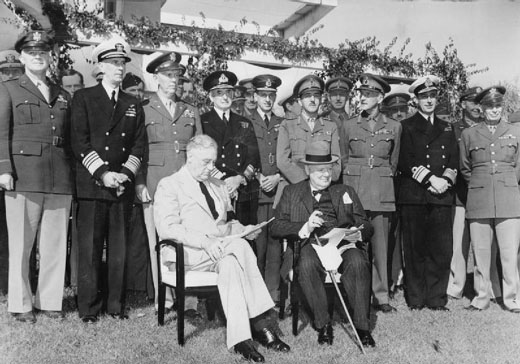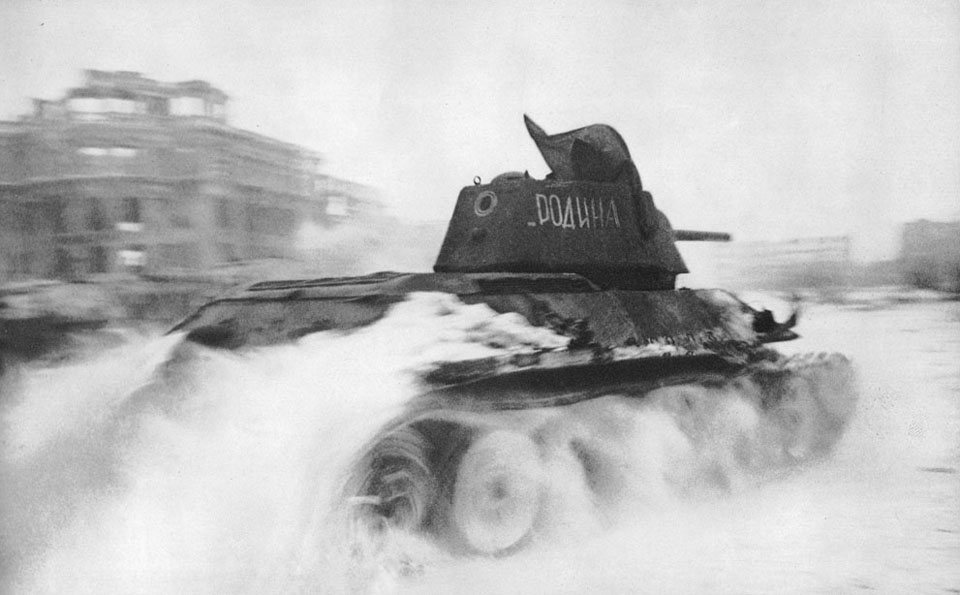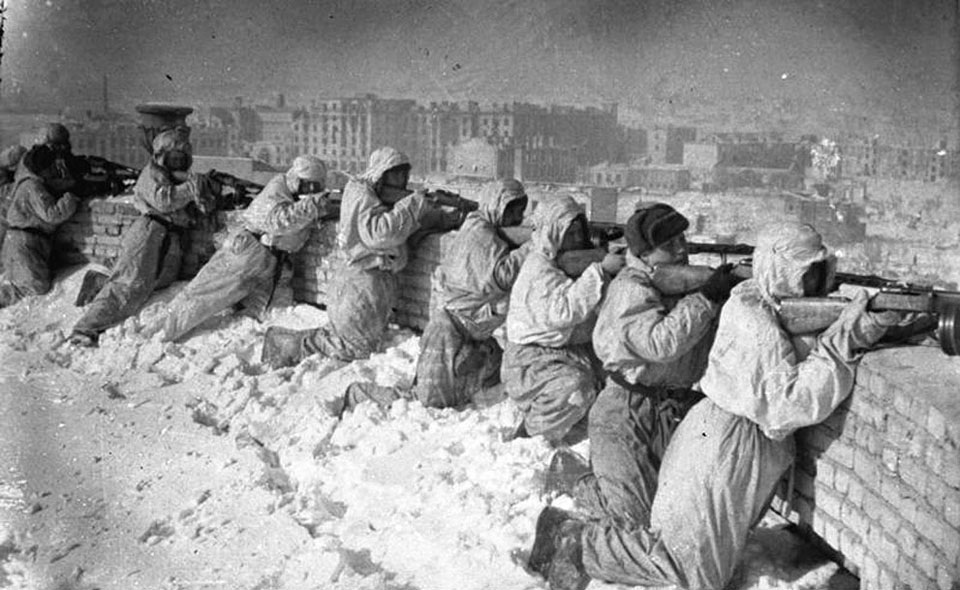Air Operations, Asia
3 Japanese bombers are shot down in 4 minutes by an RAF Beaufighter night fighter over Calcutta.
[Air Operations, Bismarcks
90th Heavy Bomb Group B-24s mount single-plane attacks against Gasmata.
[Air Operations, Europe
BOMBER COMMANDDaylight Ops:
- 6 Halifaxes are sent on a cloud-cover raid to Leer, but only 1 aircraft drops its bombs through a gap in the clouds. 7 Wellingtons of 4 Group lay mines in the Frisians.
- 1 Wellington is lost.
- 122 aircraft make the first of 8 area attacks on the French port of Lorient being used by the Germans as a U-boat base. Included in this raid are 63 Halifaxes, 33 Wellingtons, 20 Stirlings and 6 Lancasters.
- The Pathfinder marking is accurate, but the bombing later by the Main Force is described as 'wild'. This is the first bombing mission of the Canadian 6 Group.
- 2 Wellingtons are lost, 1 of which is from 6 Group.
Air Operations, Libya
In two separate actions near Gheddhia, 57th Fighter Group P-40 pilots down 3 Bf-109s and an Italian Air Force Mc-202.
[Air Operations, Mediterranean
XII Bomber Command B-25s and P-38s are sent to attack Axis shipping in the Straits of Sicily, but no ships are located. On the return flight, P-38s strafe German Army vehicles and troop concentrations along the coast.
[Air Operations, New Guinea
- 90th Heavy Bomb Group B-24s mount single-plane attacks against Finschhafen and Madang.
- V Bomber Command B-25s attack dumps near Lae.
- 3d Light Bomb Group A-20s strafe targets around Labu and small boats in the area.
Air Operations, Solomons
- 347th Fighter Group P-39s attack Japanese ground troops on Guadalcanal with improvised gasoline bombs. Supplies and landing craft are also attacked.
- 11th Heavy Bomb Group B-17s based at Henderson Field, Guadalcanal airdrop supplies to US Army ground troops who have outrun their lines of supply.
- XIII Bomber Command B-17s attack the airfield at Buka.
- A 347th Fighter Group P-39 downs a float biplane over Rekata Bay at 0900 hours.
Air Operations, Tunisia
- During the afternoon, 26 XII Bomber Command B-17s, escorted by 17 1st Fighter Group P-38s, drop more than 63 tons of bombs on the port facilites and shipping at Sfax and Sousse. 1 Bf-109 is downed by a P-38 pilot.
- 1 P-38 is lost to a Bf-109
- XII Bomber Command B-26s attack the rail junction at Kalaa Srira and warehouses and rail facilities at Mahares.
- A 52nd Fighter Group Spitfire pilot downs a Bf-109 near Cape Rosa at 1215 hours.
Allied Planning
For the next ten days, ending January 23rd, Churchill and Roosevelt meet in Casablanca accompanied by their Chiefs of Staff. Stalin is unable to attend because of military operations. There is some danger of a split between the British and Americans. The Americans feel, with some justice, that the British are doing too little against the Japanese, and the British believe, also with reason, that the Americans are gradually abandoning their commitment to the Germany-first policy. Stalin has also sent a message voicing his opinion. He maintains that there is only one important issue, the opening of a second front in Europe. This is what Stalin has been saying for months, and now he is more insistent than ever. After several days' discussion between the Chiefs of Staff, these differences are smoothed over and broad guidelines agreed. The fact that the agreement is produced principally by the Chiefs of Staff is important because the American military has felt previously that Churchill has been able to convince Roosevelt to adopt policies with which they have not been in full agreement, TORCH being the best example.
The U-boat offensive and supplies for Russia are now to have first priority. To open a new front in the West would mean that the Germans would have to defend themselves on two fronts, and so split up their forces. The Allies agree with Stalin on the need to open a second front in the West. The question is when.
The Casablanca Conference |
 |
Roosevelt and his staff are in favor of carrying out a landing in France within a few months, Churchill argues for a surprise landing in Italy, the 'soft under-belly of Europe', followed by a linking up with the Russian armies in the Balkans to attack Hitler's empire from the south. When Churchill gives his word to the Americans that he is ready to support the American plan for a landing in France, now planned for 1944, Roosevelt agrees to the preparations for the landing in Sicily.
The operations in the Pacific are to continue also and once North Africa is cleared the forces there are to move on to Sicily and Italy rather than be idle. The attack on Germany is also to be carried on by strategic bombing both day and night intensified and 'rationalized'. The object of this strategy will be the destruction of industrial production centers and cutting communications. An important directive ordering this is issued and passed on to Air Marshal Sir Arthur Harris for action. At a press conference on January 24 Roosevelt announces that the Allies are fighting for the 'unconditional surrender' of Germany, Italy and Japan and this stand is immediately endorsed by Churchill. This policy has since been criticized as perhaps having helped prolong the war. This is uncertain but it is clear that neither leader has at this stage given much thought to considering the implications of the idea. The main failing of the conference is not at first apparent. All the plans are based on false estimates of the available quantity of shipping. Shipping shortages very soon affect British plans for Burma and later this is also a problem for Mediterranean operations.
[Eastern Front
In the northern sector fighting goes on south of Lake Ladoga. The Germans are trying to drive the Russians out of the corridor through which the siege of Leningrad has been partially relieved.
The Soviets capture Pitomnik airfield, the larger of the 2 which have been held by the Germans in Stalingrad. The Soviet forces have advanced across the Chervlennaya and Rossoshka Rivers. On the Voronezh Front, the Red Army advance continues but could be more forceful if more troops were available. The sacrifices of 6th Army are not, therefore, entirely valueless. Further east the Russians break through the lines of the Hungarian 2nd Army on the Don. The position of von Manstein's and von Kleist's armies grows more serious.
Soviet Tank in Stalingrad |
 |
Soviet Soldiers in Stalingrad |
 |
The Germans counterattack north of Sinyavino, having pulled 2 infantry divisions up from Kirishi. Fierce fighting ensues as Soviet forces continue their attacks.
SOUTHERN SECTOROn the upper Don the Voronezh Front smashes the Hungarian 2nd Army. Under cover of thick fog the 3rd Tank Army enters the battle, crashing its way through the junction of the Hungarian IV and VII Corps and advancing 12 miles.
[Guadalcanal
In the coastal sector, the 8th Marines, 2nd Marine Div, is still unable to advance because of fire from a ravine west of Hills 80 and 81. The 6th Marines replaces the 2nd Marines on the left flank of the division. C Company, 35th Infantry, 25th Div, continues vain efforts to advance westward, but patrols discover a route around the enemy's right flank. Only 75 percent of the 2nd Battalion, 35th Infantry, are fit for duty; malaria and battle casualties accounting for the rest. The 35th's Antitank Company is attached to the battalion and moves into line between F and G Companies just northeast of Hill 27. Patrols from the 3rd Battalion, 182nd Infantry, attempt to find the Japanese left flank, but without success. Capt Beach's 147th Infantry force reaches Vurai. It then moves forward to Tapananja, about 6 miles south of Sealark Channel, when patrols find the Vurai area free of the enemy. Outposts are established on the upper Poha.
Japanese plans for evacuation are settled at a high level conferences in Tokyo and then in Rabaul. Gen Hitashi Imamura of the 8th Area Army comes down from Java to take charge. 9 destroyers are sent to Guadalcanal carrying 600 troops to be the rearguard of the evacuation. On the return trip the destroyers attacked by the Cactus Air Force and 4 destroyers are damanged by bombs or near misses. PT boats attack during the night but are outmaneuvered by the destroyers. 1 PT boat runs aground on a reef off Florida Island.
[New Guinea
Gen Vasey, Australina 7th Division CG, launches an offensive to intercept the enemy withdrawal from the trail junction. While the US 163rd Infantry pushes south to block escape routes, the Australian 18th Brigade quickly clears enemy remnants from the junction and joins forces with the 163rd Infantry on the Sanananda and Killerton trails. The final mop up is left to the Australian 2/6th and 39th anf 49th Battalions.
[North Africa
LIBYAThe personnel of 21st Pzr Div are withdrawn from Rommel's defense line and are sent to Gabes to re-equip. They are to be used to defend Tunisia from the western attack.
The XXX Corps, British 8th Army, moves forward in preparation for the assault on the Buerat line and the drive on Tripoli.
[Pacific
The US submarine Searaven (SS-196) attacks a Japanese convoy northwest of the Palaus, sinking the sole escort, auxiliary submarine chaser No. 1 Ganjitsu Maru, and army cargo ship Shiraha Maru (5680t).
[